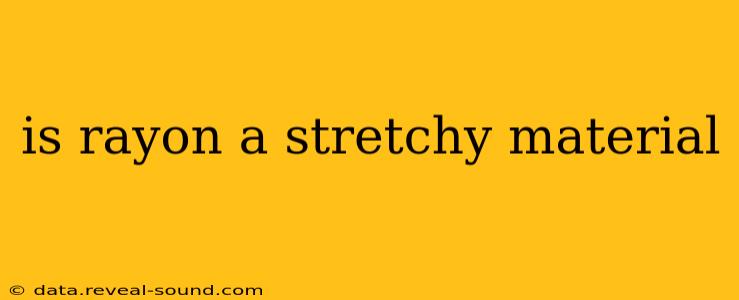Rayon, a semi-synthetic fiber derived from cellulose, is a versatile material used in a wide range of clothing and household items. However, its stretchiness is a common point of confusion. The simple answer is: no, rayon is not inherently stretchy. But the story is more nuanced than that. Let's delve deeper into rayon's properties and explore why its stretchiness is dependent on other factors.
What is Rayon Made Of?
Before we discuss stretch, understanding rayon's composition is key. Rayon is made from cellulose, a natural polymer found in plants. Through a chemical process, this cellulose is broken down and reformed into fibers. Different manufacturing processes result in various types of rayon, each with slightly different properties. This is crucial because the manufacturing process directly influences the resulting fabric's drape, texture, and, importantly, its ability to stretch.
Why Rayon Isn't Naturally Stretchy
Unlike elastane (also known as spandex or Lycra), which is inherently elastic, rayon lacks the long, coiled polymer chains that allow for significant stretching and recovery. Rayon fibers are relatively straight and rigid, meaning they don't readily return to their original shape after being stretched. Attempting to stretch rayon beyond its limited capacity may lead to permanent deformation or damage.
Can Rayon Be Made Stretchy?
While rayon itself isn't stretchy, manufacturers often incorporate techniques to enhance its flexibility and give the appearance of stretch. These techniques include:
-
Blending with Elastane: The most common method is to blend rayon with elastane. This combination utilizes elastane's inherent stretch to counteract rayon's rigidity, resulting in a fabric with improved elasticity and comfort. Look for garments labeled "rayon/spandex" or similar blends.
-
Knitting Techniques: The way the rayon is knitted or woven also plays a role. Certain knitting techniques create fabrics with more give and drape, improving their perceived stretchiness. Loose knits, for instance, will feel more flexible than tightly woven fabrics.
-
Finishing Treatments: Certain chemical treatments applied during the manufacturing process can slightly improve rayon's flexibility. However, these treatments rarely impart significant stretch.
How Does Rayon Feel?
Rayon's feel varies greatly depending on the manufacturing process and any blends. It's often described as having a soft, luxurious drape, sometimes mimicking silk or linen. The absence of natural stretch shouldn't be confused with the fabric's inherent softness or drape.
What are the Different Types of Rayon?
Several types of rayon exist, each with unique properties:
- Viscose Rayon: The most common type, known for its smooth, soft feel.
- Modal Rayon: Known for its softness, durability, and slightly higher stretch compared to viscose.
- Lyocell Rayon (Tencel): An environmentally friendly type of rayon known for its exceptional softness and strength.
Is Rayon Durable?
Rayon's durability is moderate. It's prone to wrinkling and can weaken with repeated washing, especially in hot water. Proper care, such as gentle washing and air drying, is essential to prolong its lifespan.
Is Rayon Easy to Care For?
Generally, rayon requires gentle care. Always check the garment's care label for specific instructions. Machine washing is usually recommended on a delicate cycle with cold water, followed by air drying.
In conclusion, while rayon itself isn't inherently stretchy, its perceived stretchiness can be significantly enhanced through blending, fabric construction, and finishing treatments. Understanding these factors is crucial when selecting garments or fabrics made from rayon.
